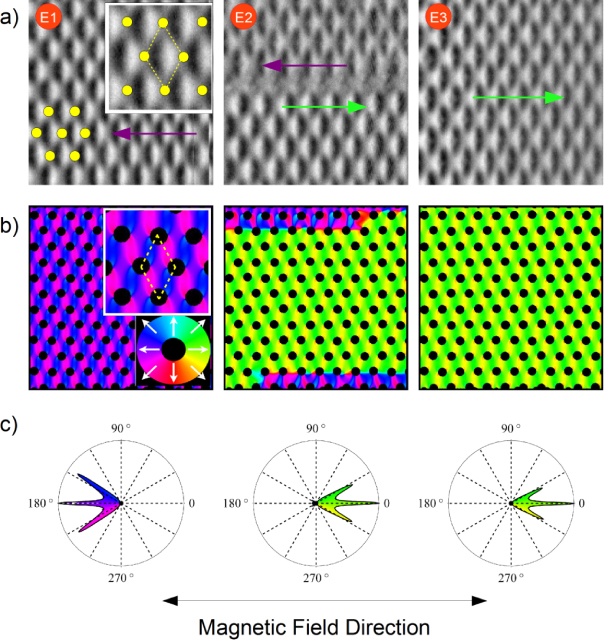Switching modes in easy and hard axis magnetic reversal in a self-assembled antidot array

We study the reversal mechanisms in a self-assembled, hexagonally ordered Fe antidot array with a period of 200 nm and an antidot diameter of 100 nm which was prepared by polystyrene nanosphere lithography. Direction-dependent information in such a self-assembled sample is obtained by measuring the anisotropic magnetoresistance (AMR) through constrictions processed by focused ion beam milling in nearest neighbor and next nearest neighbor directions. We show that such an originally integral method can be used to investigate the strong in-plane anisotropy introduced by the antidot lattice. The easy and hard axis reversal mechanisms and corresponding AMR signals are modeled by micromagnetic simulations. Additional in-field magnetic force microscopy studies allow the correlation of microscopic switching to features in the integral AMR. We find that the easy axis of magnetization is connected to a distinct periodic magnetic domain pattern, which can be observed during the whole magnetization reversal. While this process is driven by nucleation and propagation of reversed domains, the hard axis reversal is characterized by a (stepwise) rotation of the magnetization via the antidot lattice' easy axes.
| Author(s): | Haering, F. and Wiedwald, U. and Nothelfer, S. and Koslowski, B. and Ziemann, P. and Lechner, L. and Wallucks, A. and Lebecki, K. and Nowak, U. and Gräfe, J. and Goering, E. and Schütz, G. |
| Journal: | {Nanotechnology} |
| Volume: | 24 |
| Year: | 2013 |
| Publisher: | IOP Pub. |
| Project(s): | |
| Bibtex Type: | Article (article) |
| DOI: | 10.1088/0957-4484/24/46/465709 |
| Address: | Bristol, UK |
| Electronic Archiving: | grant_archive |
| Language: | eng |
BibTex
@article{escidoc:0209,
title = {{Switching modes in easy and hard axis magnetic reversal in a self-assembled antidot array}},
journal = {{Nanotechnology}},
abstract = {We study the reversal mechanisms in a self-assembled, hexagonally ordered Fe antidot array with a period of 200 nm and an antidot diameter of 100 nm which was prepared by polystyrene nanosphere lithography. Direction-dependent information in such a self-assembled sample is obtained by measuring the anisotropic magnetoresistance (AMR) through constrictions processed by focused ion beam milling in nearest neighbor and next nearest neighbor directions. We show that such an originally integral method can be used to investigate the strong in-plane anisotropy introduced by the antidot lattice. The easy and hard axis reversal mechanisms and corresponding AMR signals are modeled by micromagnetic simulations. Additional in-field magnetic force microscopy studies allow the correlation of microscopic switching to features in the integral AMR. We find that the easy axis of magnetization is connected to a distinct periodic magnetic domain pattern, which can be observed during the whole magnetization reversal. While this process is driven by nucleation and propagation of reversed domains, the hard axis reversal is characterized by a (stepwise) rotation of the magnetization via the antidot lattice' easy axes.},
volume = {24},
publisher = {IOP Pub.},
address = {Bristol, UK},
year = {2013},
slug = {escidoc-0209},
author = {Haering, F. and Wiedwald, U. and Nothelfer, S. and Koslowski, B. and Ziemann, P. and Lechner, L. and Wallucks, A. and Lebecki, K. and Nowak, U. and Gr\"afe, J. and Goering, E. and Sch\"utz, G.}
}


